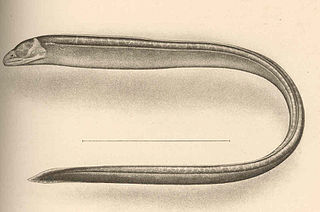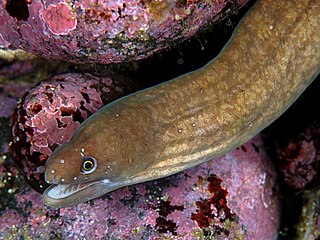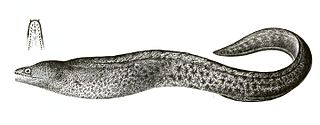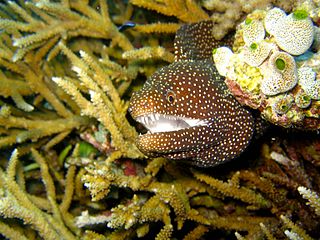Anarchias is a genus of moray eels in the family Muraenidae.

The barred moray, also known as the banded moray, the dark-banded eel, the girdled moray, the girdled reef eel, the many banded moray eel, the ringed moray, the ringed reef moray, the striped moray and the zebra eel,) is a moray eel of the family Muraenidae. It was described by John Richardson in 1845, originally under the genus Muraena. It is a marine, tropical eel which is known from the Indo-Pacific, including the Red Sea, East Africa, the Hawaiian Islands, the Marquesan Islands, the Tuamoto Islands, the Ryukyu Islands, and the Great Barrier Reef. It dwells at a depth range of 2 to 20 metres, and leads a benthic lifestyle in reefs and shallow lagoons. Males can reach a maximum total length of 72.3 centimetres (28.5 in).

Anarchias allardicei is a moray eel commonly known as the Allardice's moray. It is light brown in color, and is found in coral reefs in the Pacific and Indian Oceans.
Anarchias cantonensis is a moray eel commonly known as the Canton Island moray or the Canton moray. It was first named by Schultz in 1943 and is found in coral reefs in the Pacific and Indian Oceans.
Anarchias euryurus is a moray eel found in the eastern Atlantic Ocean. It was first named by Lea in 1913.

Anarchias leucurus is a moray eel found in the Pacific Ocean. It was first named by Snyder in 1904 as Uropterygius leucurus, and is commonly known as the Snyder's moray, fine-spotted moray, or the finespot moray. It is thought to be the smallest species of moray, and may actually represent several different species or subspecies.
Anarchias longicaudis is a moray eel found in the eastern-central Atlantic Ocean. It was first named by Peters in 1877.

Anarchias seychellensis is a moray eel found in coral reefs in the Pacific and Indian Oceans. It was first named by J. L. B. Smith Smith in 1962, and is commonly known as the Seychelles moray or the marbled reef-eel.
Anarchias similis is a moray eel found in coral reefs in the Atlantic Ocean. It was first named by Lea in 1913, and is commonly known as the pygmy moray, but is not to be confused with the Pacific species of the same name, Gymnothorax robinsi. It ranges in color and patterning from dark brown all over to blotched.
Echidna leucotaenia, the whiteface moray, also known as the white-banded moray eel, is a moray eel. It was described by Schultz in 1943. It is a tropical, marine and freshwater eel which is known from the Indo-Pacific, including East Africa, the Line Islands, the Tuamotu Islands, and Johnston Island. It dwells at a depth range of 0 to 24 metres, and leads a benthic lifestyle in reefs. Males can reach a maximum total length of 75 centimetres (30 in).

The blotch-necked moray is a moray eel found in coral reefs in the Pacific and Indian Oceans. It was first named by Pieter Bleeker in 1864, and is also commonly known as the blackpearl moray, pearly moray, pearly reef-eel, or the trunk-eyed moray.
Gymnothorax mccoskeri is a moray eel found in the western Pacific and the eastern Indian ocean. It was first named by Smith and Böhlke in 1997, and is commonly known as the McCosker's moray, many-banded moray-eel, or the manyband moray.
The drab moray is a moray eel found in coral reefs in the Pacific and Indian Oceans. It was first named by Pieter Bleeker in 1856, and is also commonly known as the brown moray, monochrome moray, monotone moray, or plain moray eel.

Gymnothorax ocellatus is a moray eel found in coral reefs in the western Atlantic Ocean. It was first named by Louis Agassiz in 1831, and is also commonly known as the blackedge moray, Caribbean ocellated moray, conger, ocellated moray, spotted moray, sawtooth moray, white-spotted moray, or yellow cong.

Gymnothorax richardsonii is a moray eel found in coral reefs in the Pacific and Indian oceans. It was first named by Pieter Bleeker in 1852, and is commonly known as the Richardson's moray, little moray, spotted-lip moray, or the Y-lined moray.
The false moray, common false moray, grey reef eel, reef eel, plain false moray, or double-toothed xenocongrid eel, Kaupichthys hyoproroides, is an eel in the family Chlopsidae. It was described by Pehr Hugo Strömman in 1896, originally under the genus Leptocephalus. It is a subtropical, marine eel which is known from coral reefs and rocky shores in the western Atlantic Ocean, including southeastern Florida, USA; the Bahamas, Yucatan, Mexico; the Antilles, and Venezuela. It is a benthic, solitary eel that typically dwells at depths to 95 m. Males can reach a maximum total length of 30 cm.
Anarchias exulatus is an eel in the family Muraenidae. It was described by Joshua S. Reece, David G. Smith, and Erling Holm in 2010. It is a subtropical, marine eel which is known from the Hawaiian Islands, Johnston Atoll, Rapa, Gambier, Pitcairn Island, and the Tonga Islands. It is an uncommon species which dwells in coral reefs and rocky regions near shores, and has been reported at a depth of 12 metres. Males are known to reach a maximum total length of 29.3 centimetres.
Anarchias schultzi is an eel in the family Muraenidae. It was described by Joshua S. Reece, David G. Smith, and Erling Holm in 2010. It is a tropical, marine eel which is known from the western Pacific Ocean, including the Caroline Islands, the Solomon Islands New Caledonia, and the Tonga Islands. It is an uncommon species which dwells at a depth range of 8–14 metres, in coral reefs and rocky regions near shores. Males are known to reach a maximum total length of 15.9 centimetres.
Anarchias supremus is an eel in the family Muraenidae. It was described by John E. McCosker and Andrew L. Stewart in 2006. It is a subtropical, marine eel which is known from Macauley Island on the Kermadec Ridge in the southwestern Pacific Ocean. Males are known to reach a maximum total length of 19.1 centimetres.
The Galapagos ridgefin eel is an eel in the family Ophichthidae. It was described by John E. McCosker and Richard Heinrich Rosenblatt in 1972. It is a tropical, marine eel which is known from four specimens collected from the Galapagos Islands, in the southeastern Pacific Ocean. It inhabits coral, sand and rock.








